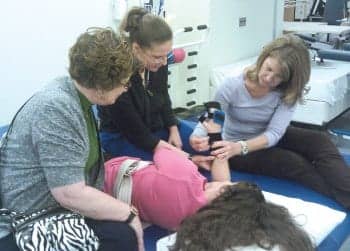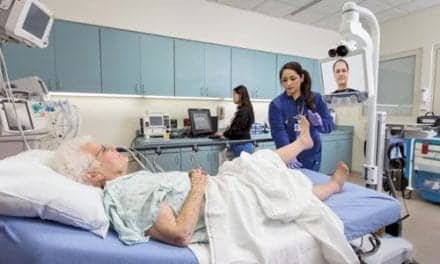
Forging an alliance between patients, caregivers, and clinicians helps guide all parties through the recovery process.
As health care providers, it is easy to assess our patients and determine their course of rehabilitation based on areas of impairment and what we, as the professional, feel their needs may be. Too often, we view our patients and set goals based on our experiences, perspectives, and perceptions on the burden of care that the injury and resulting impairments may have on the family. Instead, it is imperative that we collaborate to manage expectations and set obtainable goals that are therapeutic, functional, and important to the patients and families at the center of the plan. Our objective is meeting the needs of all of our patients, including the particular needs of stroke patients and their families, whether it be through setting functional goals, providing information in a timely and accurate manner, or listening to their concerns. Each of these is essential for provision of Patient and Family Centered Care. The challenge we face is learning how to change our way of thinking from being providers of service to being partners in care.
WHAT IS PATIENT CENTERED CARE?
Patient and Family Centered Care (PFCC) is a way of thinking; it is an attitude and an approach. It is an approach to planning, delivery, and evaluation of health care designed to create beneficial partnerships among patients, families, and health care providers.1 The four principles of PFCC are:
- Dignity and Respect: Family and patient choices, values, belief systems, and cultural backgrounds are incorporated into the daily decision-making and planning.
- Information Sharing: Information is communicated effectively and efficiently in useful and unbiased ways.
- Participation: Patients and families are encouraged to participate in care and decision-making at all levels of the continuum.
- Collaboration: All involved in care collaborate and partner in program development, education, facility design, and implementation.2
As clinicians, it can be difficult to balance what we see as successful in terms of outcomes for stroke patients with what our families and patients may have expected and view as success; however, the ultimate goal of PFCC is to create partnerships between health care professionals, patients, and families in order to effectively create the best possible outcomes and quality of life. Institutions where PFCC is implemented and is a part of the culture find that patient, family, and staff satisfaction improves, and subsequently, clinical care outcomes are improved.2 This is a result of direct collaboration throughout the entire rehabilitation process where all parties are effectively communicating about needs, goals, and expectations.
Research has shown that building relationships and therapeutic alliances between patients, caregivers, and clinicians has a significant impact on the success of outcomes, particularly within the brain injury field.3 Implementation of PFCC concepts and development of these relationships allow for identification of specific needs, which is necessary to develop a comprehensive plan that guides all involved parties through the recovery process. For a successful transition in care, it is vital that we involve the patient and the family by having open discussions regarding their needs. Patients and families want to be engaged in patient care and the decision-making process, and caregivers have reported that failure to do so often results in increased anxiety levels and exhaustion.4 Increased knowledge, ongoing education, and training assist both patients and families in understanding all aspects in their care and reduce the anxieties and fears that may be experienced while moving through the rehabilitation process.3
IMPLEMENTING PFCC
Being patient- and family-centered requires us to modify how we provide services to stroke patients. As clinicians, there are improvements we can make to our typical practices to help consumers become and feel more involved:
- Open visitation to family members. Family members should not be labeled as visitors and should become actively involved in daily therapy sessions and care.2 Not only does this increase the level of comfort as it relates to taking care of a loved one, it also allows families to observe and participate in daily activities. This time can be used to initiate training that helps families become effective caregivers and also educate patients to become advocates for the care they need. Involving families early allows time for them to have questions answered and to ponder what they may need in the home before discharge. It also helps them acquire and gradually apply all of the new skills they have learned.
- Encourage patients and families to establish goals. Provide opportunities to set daily, weekly, and long-term goals for rehabilitation. It is important to address the patients’ and families’ daily goals and needs. Working with our families and patients to help them set obtainable short- and long-term goals and guide them through the goal setting process will ensure a successful discharge plan. It is our responsibility to assist families in scaffolding their ultimate goals without negating their hopes and desires.
- Provide patients and families with all the information needed to advocate for themselves. They should be privy to all information regarding their care in order for them to work through the decision-making process effectively by asking questions and sharing information.2 Information should be provided in multiple formats, dependent upon the learning styles and should include but not be limited to verbal and written communication and hands-on demonstration.
- Allow patients and families to make choices. Even small decisions are important, from choosing what they will have for each meal, to deciding what will occur during their recreational time. Making these types of daily decisions can make a difference in how patients and families perceive the level of participation they have in their care.
- Choose therapy activities that are meaningful to the patient. If the patient had an interest in computers prior to a stroke, develop therapy tasks for which they can utilize a computer system. If they previously performed manual work, choose physical and occupational therapy tasks that mirror the work they performed prior to injury. These types of activities will encourage increased patient participation because they find tasks more purposeful and have a better understanding of how activities relate to their daily lives.
- Schedule time to have individualized, collaborative meetings with patients and families. This allows time to discuss goals and progress and develop a plan for successful discharges and/or home care. In addition, as individual team members all conversing with our patients and families, it is imperative to keep our communication open and ongoing to ensure we are receiving and providing the same information.
As clinicians, there are barriers and challenges we face in our quest to incorporate PFCC. Perhaps most difficult is finding the balance and managing our time between providing the treatment necessary to meet goals and outcomes, and ensuring that our patients and families are involved. However, being united in efforts should show a return on functional independence, caregiver burden, and patient and family satisfaction. Changing the culture will help eliminate stressors and additional time spent in service recovery efforts.
TREATING EFFECTIVELY
Not only is it important for us to involve our patients and families throughout every step of their care, it is also important that we focus treatments on personal and family roles, needs, and goals. Do not hesitate to ask the family, “What is it you need for your loved one to be able to do?” or to ask the patient, “What is important to you?” Spending time interviewing patients and families to discover family and household roles, details of their occupations, and hobbies will assist in the development of treatments that are functional, meaningful, and patient-focused.
Consider a family that relays to its clinicians one of their loved one’s daily tasks was to retrieve and sort the mail. This task could be accomplished through interventions and treatments using an interdisciplinary team approach. While speech therapy is incorporating sorting, categorizing, sequencing, problem solving, reading, and writing, occupational therapy could address vision and/or neglect, fine motor skills, sequencing, problem solving, and Instrumental Activities of Daily Living (IADLs) with the same activity. Physical therapy could address dynamic and static sitting balance, standing, and mobility, whether it be wheelchair mobility or ambulation. Each skill is vital for appropriate and effective task completion.
To another family, it may be important that their loved one is able to use a toilet for bowel and bladder management. As clinicians, it is important we attempt to honor their request by initiating training for the task. Training, again, should include all disciplines, incorporating discipline-specific interventions. In this case, speech therapy could address verbalizing toileting needs and sequencing the steps of a transfer. Occupational therapy could address transfers to and from toileting equipment, self-care, and clothing management. Physical therapy could examine transfers, mobility, and sitting balance for use of equipment. Other tasks could include bathing, dressing, grooming, cooking, laundry, and/or grocery shopping, dependent upon individual patient and family input.
CONCLUSION
Patient and family centered care is an integral part of a successful rehab culture. It is imperative we incorporate our patients and families into their care beginning with our initial meetings. Doing so has a positive impact on both our relationships and our therapeutic outcomes, and by working together, each party involved may feel their role played an integral part in the success of the client. In making the decision to move toward and implement Patient and Family Centered Care, we need to incorporate our patient and family input into the decision-making process. We should ask our patients and families, “What is important to you?”
Noell D. Gibson, MA, CCC/SLP, is a staff speech-language pathologist at the Shepherd Center in Atlanta for the Acquired Brain Injury Program. For more information contact .
REFERENCES
- Kreutzer JS, Marwitz JH, Godwin EE, Arango-Lasprilla JC. Practical approaches to effective family intervention after brain injury. J Head Trauma Rehabil. 2010;25:113-120.
- Institute for Family Centered Care. Strategies for Leadership: Advancing the Practice of Patient- and Family-Centered Care.
- Ponte P, Conlin G, Conoway JB, et al. Making patient-centered care come alive. J Nurs Adm. 2003;33(2):82-90.
- MacIsaac L, Harrison M, Buchanan D, Hopman W. Supportive care needs after an acute stroke: a descriptive enquiry of caregivers’ perspective. J Neurosci Nurs. 2011;43(3):132-140.





